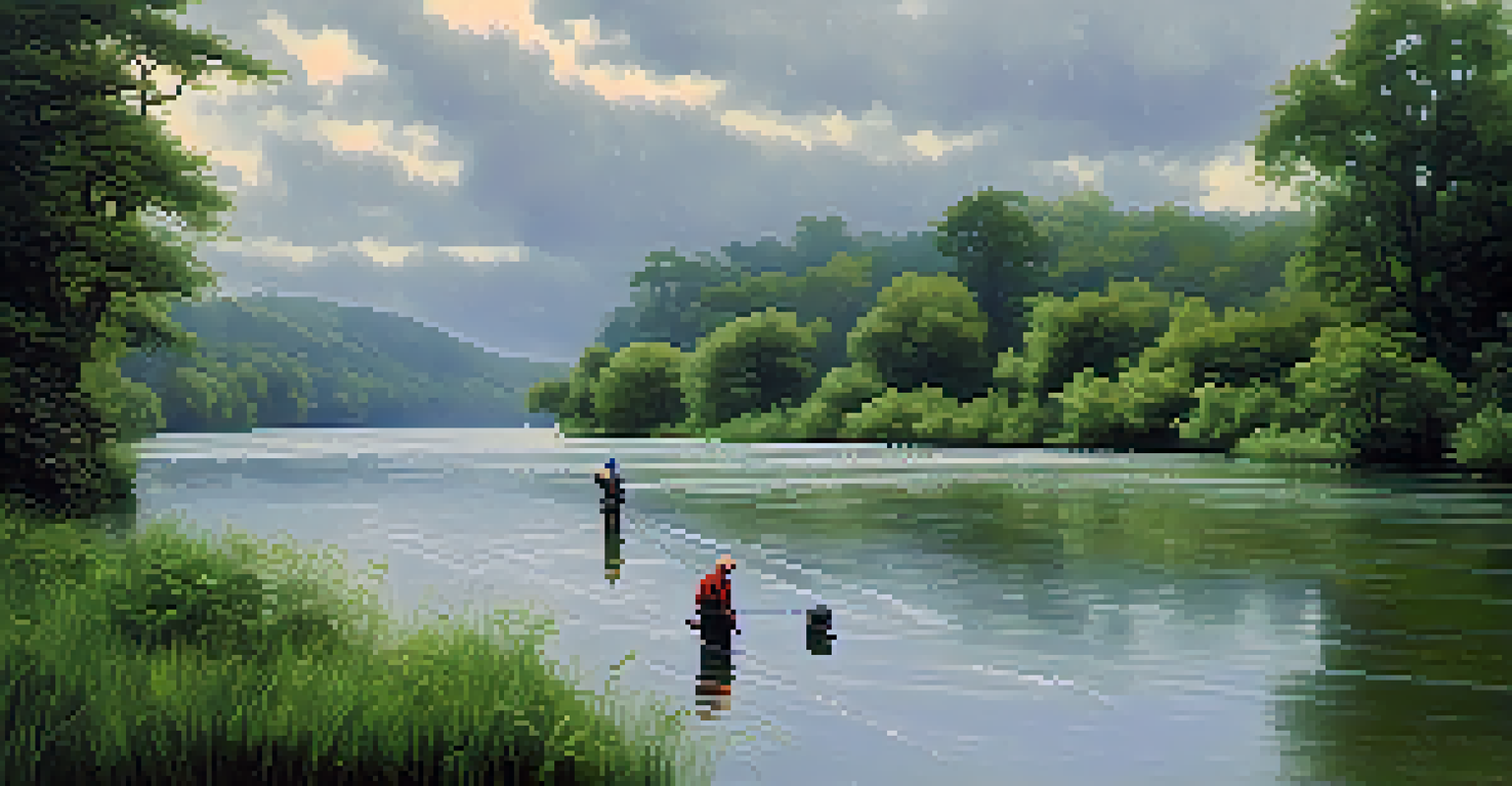How Weather Affects Fishing Success: Key Insights

The Role of Temperature in Fish Behavior
Temperature plays a crucial role in determining fish activity. Warmer waters often lead to increased fish metabolism and movement. This means that on sunny days, you might find fish more actively feeding, especially in shallow areas where the water warms up faster.
Fishing is not an escape from life, but often a deeper immersion into it.
Conversely, cooler temperatures can drive fish to deeper waters, where they feel more comfortable. During the early spring or late fall, for instance, anglers may notice a shift in where fish are located, as they seek out warmer spots or retreat to deeper, stable environments.
Understanding these temperature dynamics can significantly enhance your fishing success. By checking local forecasts and water temperatures before heading out, you can strategize your fishing approach to align with fish behavior.
How Cloud Cover Affects Fishing Conditions
Cloud cover can be a double-edged sword for anglers. On one hand, overcast skies can reduce light penetration, making fish feel more secure and willing to roam closer to the surface. This can lead to more successful catches, especially during midday when the sun is typically at its peak.

On the other hand, too much cloud cover can also hinder certain types of fishing, like surface lure techniques. If the clouds bring rain, it might stir up the water, which can either help or hurt visibility for both fish and fishermen depending on the situation.
Temperature Affects Fish Activity
Warmer temperatures can increase fish metabolism and movement, making them more active and easier to catch.
Ultimately, knowing how to read cloud patterns can give you an edge on the water. Observing how fish respond to different light conditions can help you choose the right time and method for your fishing adventures.
The Impact of Wind on Fishing Locations
Wind can dramatically change fishing conditions on the water. A light breeze can help break the surface tension, allowing fish to feed more freely on the surface. This is why many anglers swear by fishing during windy days, as it can lead to increased surface activity.
The tug is the drug.
However, strong winds can make fishing more challenging. High winds can result in choppy water, making it difficult to cast and retrieve effectively. Additionally, fish may retreat to calmer areas, which might require you to adjust your fishing strategy and location.
Understanding how wind influences fish behavior is key. By observing wind patterns and adapting your approach accordingly, you can enhance your chances of a successful catch, whether it means changing your bait or seeking out sheltered spots.
Rain: A Blessing or a Curse for Anglers?
Rainy weather can be a mixed bag for fishing. While heavy downpours may deter some anglers due to uncomfortable conditions, fish often become more active. The influx of fresh water can stimulate feeding, especially in rivers and streams where currents are altered.
Additionally, rain can wash insects and other food sources into the water, attracting fish to the surface. This is an excellent opportunity for anglers who enjoy fly fishing or topwater techniques, as fish will be more inclined to strike at prey in these conditions.
Cloud Cover Impacts Fishing Success
Overcast skies can enhance fish feeding behavior, but excessive cloudiness may hinder certain fishing techniques.
That said, too much rain can muddy the water and reduce visibility, making fishing more challenging. Knowing how to gauge the effects of rain on your local waters can help you decide when to brave the elements for a fruitful fishing trip.
Barometric Pressure: What You Need to Know
Barometric pressure can significantly influence fish behavior. Fish are sensitive to changes in pressure, which can affect their feeding patterns and movement. Generally, a falling barometer often signals that fish will be more active and willing to bite, especially before a storm.
Conversely, a rising barometric pressure may lead to a slowdown in fish activity. During these times, fish can become more lethargic, making it essential for anglers to adapt their tactics, possibly opting for slower baits or deeper water locations.
Monitoring barometric pressure before and during your fishing trip can provide valuable insights. By understanding its effects, you can better anticipate when fish are likely to be feeding, enhancing your chances of success on the water.
Seasonal Changes and Their Fishing Implications
The changing seasons bring distinct fishing opportunities and challenges. In spring, as temperatures rise, fish start to spawn, making them more active and easily catchable. This time is often considered prime fishing season for many species.
Summer presents a different scenario, where fish may retreat to cooler, deeper waters during the hottest parts of the day. Understanding these seasonal shifts allows anglers to adjust their fishing times and locations for optimal success.
Understanding Tides Boosts Fishing
Fishing during incoming and outgoing tides can significantly improve your chances of a successful catch.
Fall brings another transition, as fish prepare for winter by feeding aggressively. By keeping an eye on seasonal changes and adapting your strategies, you can make the most of each fishing season and maximize your catch.
Tides and Their Influence on Fishing Success
For those fishing in coastal areas, understanding tides can be critical. Tides affect water levels, currents, and fish movement, which can all impact your fishing success. Many anglers find that fishing during incoming and outgoing tides can yield better results.
During high tide, fish may be more inclined to venture into shallower waters to feed. Conversely, low tide can push fish back to deeper areas, which may require adjustments in your fishing approach and bait selection.

By planning your fishing trips around the tide schedule, you can take advantage of these natural rhythms. Being mindful of tides can lead to more productive outings and a greater understanding of local fish behaviors.